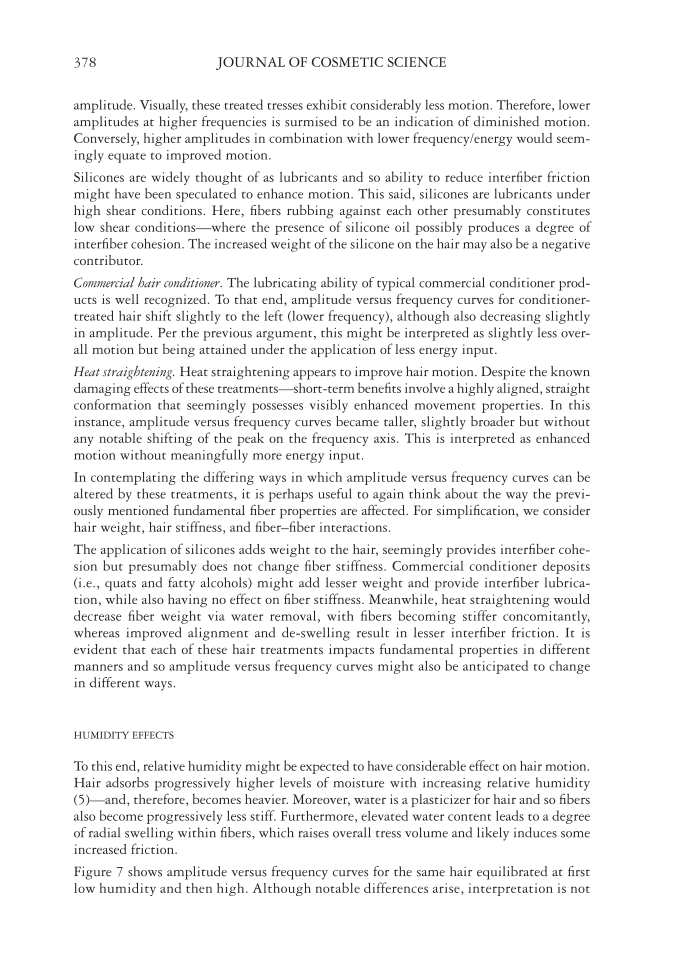JOURNAL OF COSMETIC SCIENCE 378 amplitude. Visually, these treated tresses exhibit considerably less motion. Therefore, lower amplitudes at higher frequencies is surmised to be an indication of diminished motion. Conversely, higher amplitudes in combination with lower frequency/energy would seem- ingly equate to improved motion. Silicones are widely thought of as lubricants and so ability to reduce interfi ber friction might have been speculated to enhance motion. This said, silicones are lubricants under high shear conditions. Here, fi bers rubbing against each other presumably constitutes low shear conditions—where the presence of silicone oil possibly produces a degree of interfi ber cohesion. The increased weight of the silicone on the hair may also be a negative contributor. Commercial hair conditioner. The lubricating ability of typical commercial conditioner prod- ucts is well recognized. To that end, amplitude versus frequency curves for conditioner- treated hair shift slightly to the left (lower frequency), although also decreasing slightly in amplitude. Per the previous argument, this might be interpreted as slightly less over- all motion but being attained under the application of less energy input. Heat straightening. Heat straightening appears to improve hair motion. Despite the known damaging effects of these treatments—short-term benefi ts involve a highly aligned, straight conformation that seemingly possesses visibly enhanced movement properties. In this instance, amplitude versus frequency curves became taller, slightly broader but without any notable shifting of the peak on the frequency axis. This is interpreted as enhanced motion without meaningfully more energy input. In contemplating the differing ways in which amplitude versus frequency curves can be altered by these treatments, it is perhaps useful to again think about the way the previ- ously mentioned fundamental fi ber properties are affected. For simplifi cation, we consider hair weight, hair stiffness, and fi ber–fi ber interactions. The application of silicones adds weight to the hair, seemingly provides interfi ber cohe- sion but presumably does not change fi ber stiffness. Commercial conditioner deposits (i.e., quats and fatty alcohols) might add lesser weight and provide interfi ber lubrica- tion, while also having no effect on fi ber stiffness. Meanwhile, heat straightening would decrease fi ber weight via water removal, with fi bers becoming stiffer concomitantly, whereas improved alignment and de-swelling result in lesser interfi ber friction. It is evident that each of these hair treatments impacts fundamental properties in different manners and so amplitude versus frequency curves might also be anticipated to change in different ways. HUMIDITY EFFECTS To this end, relative humidity might be expected to have considerable effect on hair motion. Hair adsorbs progressively higher levels of moisture with increasing relative humidity (5)—and, therefore, becomes heavier. Moreover, water is a plasticizer for hair and so fi bers also become progressively less stiff. Furthermore, elevated water content leads to a degree of radial swelling within fi bers, which raises overall tress volume and likely induces some increased friction. Figure 7 shows amplitude versus frequency curves for the same hair equilibrated at fi rst low humidity and then high. Although notable differences arise, interpretation is not
QUANTIFYING HAIR MOTION 379 straightforward. As per previous arguments, the increased maximum amplitude of motion at low humidity might be suggested as an indication of enhanced motion. Or, conversely, the ability to generate a given amplitude of motion using lesser frequency (energy) at high humidity might similarly be noted. REPRODUCIBILITY Any testing of hair fi bers and/or hair tresses is subject to issues relating to the high vari- ability of the substrate. It is therefore necessary to run a suffi cient number of replicate samples to afford an ability to perform suitable statistical analyses. Figure 8 shows a graph containing amplitude versus frequency curves for fi ve experiments on the exact same hair tress. The hair was initially subjected to motion testing at progressively higher frequencies. The tress was then carefully removed from the instrument, remounted and run three times more in the exact same manner. The dotted line shows a best-fi tting curve through these very tight data points. However, before one fi nal replicate experiment, the hair tress was given a somewhat vigorous shake. Figure 8 also shows how a very different shaped curve arises after this shaking. Here again a parallel is drawn to the related attributes of hair body and volume where sizable changes in this property can be induced by manipulation after the treatment process. For example, static air drying of hair will produce very different volume and body char- acteristic in comparison with the same hair dried with some degree of agitation. In short, this manipulation can have an overriding impact on the desired property which exceeds Figure 7. Amplitude versus frequency curves for common hair at low and high humidity.
Purchased for the exclusive use of nofirst nolast (unknown) From: SCC Media Library & Resource Center (library.scconline.org)









































































































